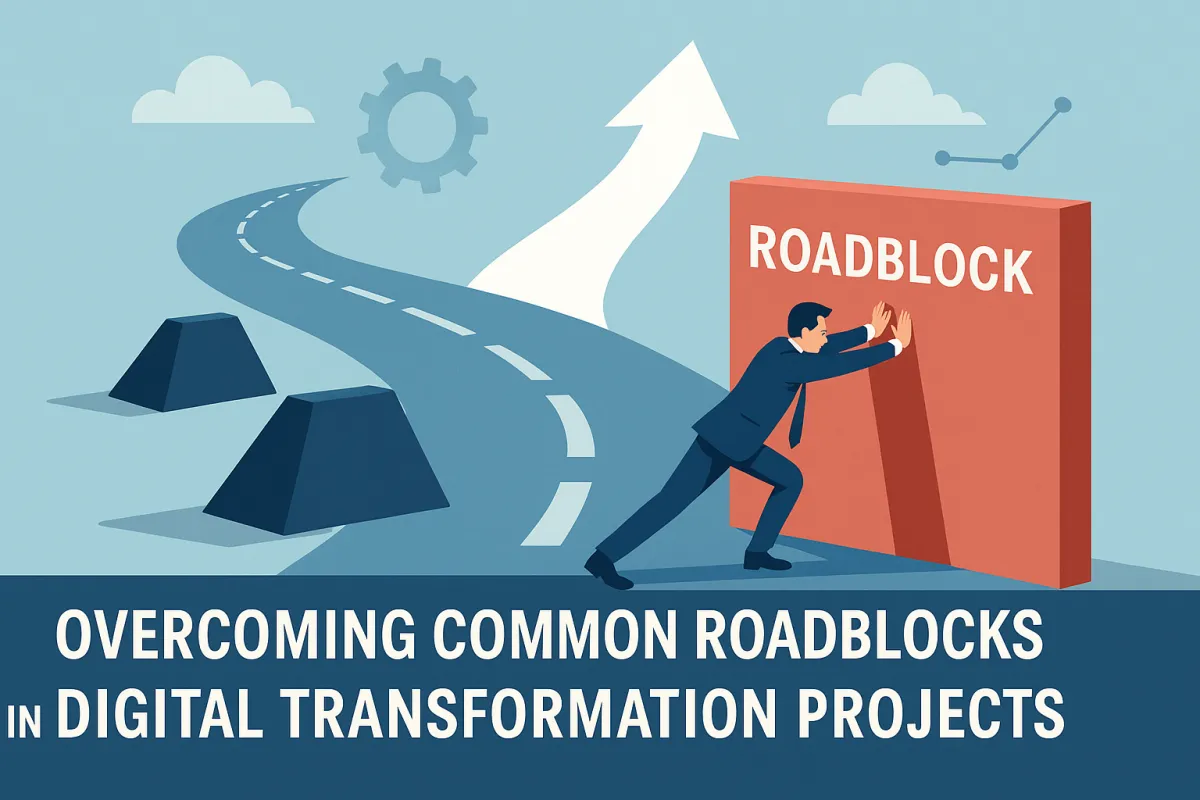Blogs
Blog

Clearing the Path to Digital Success
Digital transformation is powerful—but it’s not always easy. Many businesses start with excitement, only to run into problems that slow them down or halt progress. But if you know these roadblocks ahead of time and plan for them, you can move forward confidently.
Below, you’ll find key challenges that often trip up digital transformation projects, and practical ways to overcome them.
1. Lack of Clear Vision or Strategy
A frequent mistake is beginning a transformation without a clear plan or measurable goals. Without a roadmap, projects can drift, priorities clash, and money gets wasted.
How to overcome it:
Define what success looks like in concrete terms (e.g. reduce manual hours by 30%, increase customer satisfaction by 20%).
Build a phased roadmap: small steps that lead to bigger changes.
Make sure every initiative aligns with your core business goals.
2. Resistance to Change
People are naturally cautious. When new tools or processes arrive, employees may feel nervous: “Will this make my job harder? Will I lose my role?”
How to overcome it:
Communicate early and often. Explain why the change is happening and how it helps.
Involve your staff in the process—get input, feedback, let them test new features.
Use training, support, and encouragement rather than forcing adoption.
3. Poor Training or Support
Even with the best tools, if your team isn’t trained or supported, adoption fails. People stop using features, revert to old habits, or get frustrated.
How to overcome it:
Provide training in small, digestible sessions—not all at once.
Use real-life examples so people see how new tools help them.
Offer ongoing support (helpdesk, documentation, peer mentors).
4. Fragmented Systems & Integration Issues
Many companies adopt new software without considering how it will connect to existing systems (accounting, CRM, scheduling). The result: data silos, duplicated work, and confusion.
How to overcome it:
Map your existing systems and data flows before selecting new tools.
Choose solutions that integrate readily or use APIs.
Plan data migration carefully and test early.
5. Lack of Measurable Metrics
If you can’t measure progress, you won’t know what’s working and what’s not. Many projects fail because no one tracks real outcomes (adoption rate, time saved, etc.).
How to overcome it:
Before you begin, choose a few key metrics (KPIs): user adoption, time saved, error reduction, etc.
Monitor continuously and adjust as needed.
Use dashboards and reports that everyone can see.
6. Skill Gaps & Talent Shortage
Not everyone on your team has technical skills. You may struggle with staffing people who can manage, maintain, or extend digital systems.
How to overcome it:
Train existing employees where possible.
Hire or contract specialists for critical areas.
Partner with agencies or vendors who can fill gaps.
7. Security, Privacy & Data Concerns
When you move to digital systems, you expose yourself to risks: data leaks, compliance issues, breaches. These fears often slow down or block transformation.
How to overcome it:
Build security into your project from day one (not as an afterthought).
Use strong data governance, encryption, and access control.
Educate your team about safe use, backups, and risks.
Pulling It All Together
Overcoming these roadblocks is a matter of preparation, clear communication, and continuous adjustment. Even if you face one or two of these challenges, you don’t need to stop your transformation. Use the tips above to anticipate trouble and stay on track.
If you want help planning around these barriers and building a transformation strategy that will succeed, don’t go it alone. Reach out to us at CLR Solutions and we’ll help you design a path forward.
5 FAQs
Q1. How do I know which roadblock will hurt me most?
A: Start by looking at what’s already causing friction—if people resist new tools, training is your weak point; if systems don’t talk to each other, integration is your issue. Want a diagnostic to find your biggest barrier? Contact us here
Q2. Isn’t resistance to change unavoidable?
A: Some resistance is normal, but you can reduce it by involving people early, showing benefits, listening to concerns, and giving support. We can help you build a change-friendly plan. Reach out
Q3. What if I don’t have a big budget to hire new talent?
A: Use a mix of training for current staff and outsourcing small projects. Also, pick tools that don’t require deep in-house expertise. We can help you pick cost-effective tools. Contact us
Q4. How long does it take to overcome these roadblocks?
A: It varies. Some changes—like training or communication—can start showing impact in weeks. System integration or culture shifts might take months. We can estimate a timeline for your business. Let’s talk
Q5. What’s the first thing I should do to avoid these issues?
A: Start by creating a clear vision with specific goals, and communicate it to your team. From there, plan for change management and training before launching tools. Need help building your vision and plan?We’re here

Whether you’re looking to increase visibility on search engines, build a stronger brand or increase traffic to your website, you need a Digital Marketing Company that can deliver the desired results.
Copyright © 2025 CLR Solutions. All Rights Reserved. Powered by CLR Solutions

Explore a better way to grow

Whether you’re looking to increase visibility on search engines, build a stronger brand or increase traffic to your website, you need a Digital Marketing Company that can deliver the desired results.



















